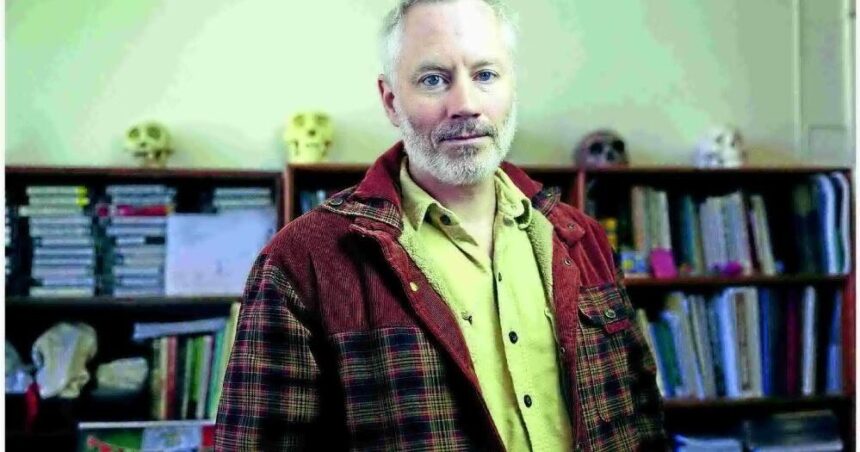Intelligent beings from distant worlds or times might live hidden in underground colonies on earth or even be walking among us, passing as humans.
These are among the theories proposed in an academic paper by Michael Masters, a professor of biological anthropology at Montana Technological University and two co-authors who are scientists affiliated with Harvard University.
An introductory authors’ note, striking a rare tone of humility for such scholarly papers, offers a caveat: “We would also like to emphasize that we believe this hypothesis to be in all likelihood false, but nevertheless believe it still merits scientific investigation.”
In short, the authors ask readers to keep an open mind. And many seemingly do.
Starting June 10, a Monday, the imagination-firing paper of nearly 35,000 words went viral after being uploaded to ResearchGate.
People are also reading…
“We started to get a sense that people were paying attention by Tuesday or Wednesday, and by Thursday my life was absolutely insane,” Masters said. “I would conservatively estimate that stories about the paper reached hundreds of millions of people, in more than 100 countries. And in a matter of three or four days. It was wild to see.”
The paper, titled “The cryptoterrestrial hypothesis: A case for scientific openness to a concealed earthly explanation for Unidentified Anomalous Phenomena,” will be published in print in October by the journal “Philosophy and Cosmology.”
Frequent reports from credible sources — including military pilots and intelligence agency whistleblowers — of Unidentified Anomalous Phenomena, or UAP, formerly known as Unidentified Flying Objects, could reflect that beings referred to as “cryptoterrestrials” might venture out from bases on earth, the paper suggests.
In this usage, “crypto” refers, in part, to the concealed status of such sentient beings.
David Grusch, an Air Force veteran who worked in the National Geospatial-Intelligence Agency, has alleged that the U.S. government and private aerospace companies have for decades maintained a secret “crash retrieval” and “reverse engineering” program to study UAP. The paper references his testimony.
The demands and logistics of either interstellar travel or time travel defy contemporary human comprehension. Fighter pilots who have captured images of UAP and shared their observations have marveled at the crafts’ uncanny maneuverability and speed of travel.
Reasonable speculation would conclude that such travel likely isn’t without challenges and risks.
Masters and co-authors Tim Lomas and Brendan Case, both at Harvard, suggest it seems likely that extraterrestrial beings or visitors from our own evolved future would want to establish hidden bases on earth to conduct reconnaissance or research or protect us from ourselves.
“They may be living on this planet, sharing this planet, as opposed to constantly coming and going,” Masters said during a June 20 interview in his office at Montana Tech.
Masters specializes in biological anthropology, paleoanthropology and modern human variation. His previous work has described human evolution and physiological adaptations driven by enlarging brains and the associated effects on craniofacial anatomy.
The stereotypical portrait of aliens, with enlarged heads and contracted facial features, might foreshadow the appearance of the human form thousands of years in the future.
“They seemingly have characteristics we would expect to see in our future if the same dominant evolutionary trends throughout the last 6 to 8 million years continue into that future,” Masters said.
“We’ve gotten past the point where we’re debating whether UFOs are real,” he said. “We’re now starting to talk about the beings who are piloting them. And we’re trying to have an open conversation about some theories about who they might be, about where and when they might be from.
“So, the root of all of this is that we should be having an open-minded, grounded conversation about an earthly explanation for UAP,” Masters said.
Understanding the weirdness
It’s admittedly strange territory for scientific analysis, he said.
“To understand the weirdness, maybe we have to look beyond our conventional reality and space and time,” Masters said. “And start to entertain some of these seemingly wild hypotheses that in the future might not seem strange at all, especially if some of them turn out to be true.”
Masters suggests that humans from our distant future might time travel to our present to study their own history and physiological evolution. That’s one explanation, he said, for accounts of alien abduction events featuring what amounted to medical exams. He has interviewed people who have reported such experiences and found consistent descriptions of the encounters.
“It’s a global phenomenon and it’s been happening throughout antiquity,” Masters said. “You can’t help but take it seriously. And we’re talking about thousands and thousands of people. I came into all of this with a very skeptical yet open mind. And my mind has continued to open more.”
Science fiction tales often portray aliens as malevolent beings bent on conquering and colonizing earth.
Masters’ research has not found evidence of such malice in alien abduction accounts. Any negative effects, such as radiation burns accidentally suffered when a ship powers up and leaves, have seemingly been unintended, he said.
“To my knowledge, no harm has come except for the ontological shock, the psychological shock of having your world view completely cracked open,” he said. “Looking at thousands of cases, no one’s been injured intentionally. In fact, most people experience a transcendental love and light. They’re shown this world that exists on a level I think all humans would love to achieve.”
Ongoing human evolution that selects for pro-social behaviors could lead us there, Masters said.
For now, the human race’s capacity for self-destruction, through nuclear weapons or environmental degradation, would certainly concern humans from a distant future and compel their interest in time travel for self-preservation, he said.
As an anthropologist, Masters said he would love to time travel into the past and study human ancestors. If he did, his appearance and technological sophistication would likely thoroughly unnerve any beings he encountered.
Meanwhile the authors describe the apparent technological prowess of UAP based on reports from pilots, submariners and other naval personnel and other witnesses of the crafts’ movements through both air and water.
“They are said to move at incredible speeds, and are capable of sudden and rapid acceleration, deceleration and direction changes, all without any visible means of propulsion or control,” the authors report.
Separately, the paper quotes the late Edgar Mitchell, the former Apollo astronaut, who talked in 2008 about visitations by extraterrestrial beings. “Yes, there have been E.T. visitations, there have been crashed craft, and bodies recovered. We are not alone in the universe; they have been coming here a long time.”
Coming and staying, the study’s authors suggest — to avoid the slings and arrows of interstellar space travel or time travel.
The “cryptoterrestrials” theory “may be exceedingly improbable, but hopefully this paper has shown it should nevertheless be kept on the table as we seek to understand the ongoing empirical mystery of UAP,” the paper suggests.
Masters was asked whether a willingness to weigh in as a scientist about mysteries not yet understood requires a thick skin.
“Elephant skin,” he replied, smiling.
Having the conversation is what’s important, Masters said.
“It transcends any individual. It is too important to worry about how people react to me as a person. What I and Tim and these other collaborators are trying to do is open people’s minds to these possibilities that exist on a cosmic scale.”





